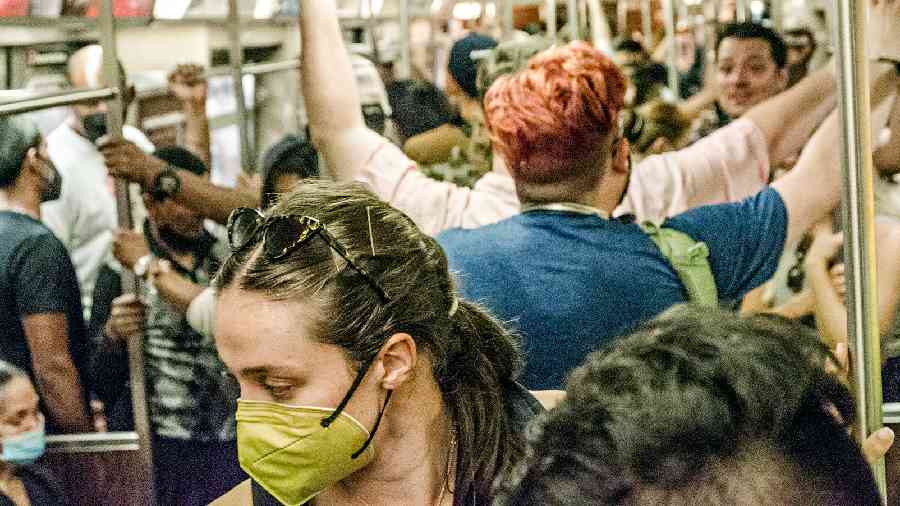In early March 2020, a group of scientists walked out of the Centers for Disease Control and Prevention in Atlanta, US. They left quietly through the building’s front doors, flashing their badges at guards, instead of through side exits where their departures would be recorded.
Gathering in a small park across the street, they stood with their coffees in hand and agonised over some shocking developments.
All through February 2020, agency scientists had been gathering evidence that the new coronavirus was being spread by people without symptoms. In early March, theCDC said that any employee who had been deployed elsewhere to track Covid-19 must isolate at home for 14 days, whether or not he or she had symptoms.
To the scientists gathered outside, trainees in the agency’s vaunted Epidemic Intelligence Service, the implication was clear: CDCleaders realised that the virus was being spread not just by people who were coughing and sneezing, but also by people who were not visibly ill. But the agency had not yet warned the public.
“All of us knew tens of thousands were going to die, and we were helpless to stop it,” said Dr Daniel Wozniczka, one of the trainees.
It is generally known that morale at the CDC plummeted as Trump administration officials sought to squelch dissent among career scientists who disagreed with the White House’s handling of the pandemic. But few employees have described the despair inside the beleaguered agency as hospitals overflowed with patients and bodies piled up in makeshift morgues.
Interviews with 11 current and former agency employees, including trainees at the EIS, as well as a review of text messages and other documents obtained by The New York Times, portray an agency under intense pressure from the country’s political leaders. Some younger staff members wrestled with guilt, anger and a rising sense of powerlessness as administration officials meddled with or simply disregarded important scientific research.
Wozniczka, 35, left the CDC in July 2021 and sought help from Whistleblower Aid, a nonprofit legal organisation. He testified before a House subcommittee on the pandemic last August and October, describing a disconnect between what CDC’s scientists were learning about the coronavirus in early2020 and the agency’s public stance on the risks.
Other scientists still at the CDC spoke on the condition of anonymity because they feared repercussions at work.The early days of the pandemic marked “an unprecedented and extremely challenging time for everyone working in public health,” the CDC said in a statement, adding that it was “particularly challenging” for new EIS officers who were deployed to places without the usual social support networks.
“CDC was clear at the beginning of the pandemic that Covid-19 was a new disease, and we were still learning how it spreads, the severity of illness it causes, and to what extent it may spread in the United States,” the agency said.
The agency said its recommendation for staff to isolate, symptoms or not, was “based on the incubation period for Covid-19” and was consistent with guidance from the State Department for people who had travelled to certain countries.
It was an extraordinarily difficult time even for veteran scientists at the agency, said Dr Anne Schuchat, the CDC’s principal deputy director until her retirement in May 2021.
If they were silent about the risks to the public, it was only because government researchers were muzzled by the Trump administration, she said. But “most of the media was vilifying the agency”.
The first big shock came in February 2020, when the Trump administration reprimanded Dr Nancy Messonnier, a senior CDC official, for warning Americans to prepare for a pandemic.
Two days later, CDC employees were told that all messaging from the agency would be routed through Vice-President Mike Pence, who had assumed leadership of the coronavirus task force.
Things were unfolding strangely on the ground, as well. EIS officers were dispatched to airports nationwide to screen passengers arriving from China for infection with the new virus — but told not to wear masks, so as not to alarm the public.
At any rate, EIS officers quickly saw the futility of screeningfor symptoms.
Data emerging from China and elsewhere strongly suggested asymptomatic spread, and the airport screenings seemed to support it. As Wozniczka became increasingly alarmed, Dr Paul Kitsutani, Wozniczka’s supervisor, encouraged him to share his concerns with superiors in Atlanta. (Kitsutani retired from the CDC in 2021.)
When Wozniczka returned to Atlanta, he realised that the possibility of asymptomatic transmission was a surprise to no one. All through February, agency scientists had reviewed increasingly compelling evidence, and data from the CDC’s own investigation of residents at nursing homes in Seattle in early March confirmed it.
It was only on March 30 that CDC director Dr Robert Redfield warned of asymptomatic transmission of the novel coronavirus in a radio interview. On April 3, at a White House press briefing, the agency advised Americans to wear masks.
Redfield did not respond to a request for comment, but he and other top officials at the CDC told the House Select Subcommittee on the Coronavirus Crisis that the White House denied the agency’s requests to hold press briefings on mask guidance. “For a while, none of our briefings were approved,” Redfield told the committee last year.
The delay in warning the public was a profound regret, Wozniczka said. “I wish I had taken my cellphone and just live-streamed myself yelling at the top of my lungs,” he said. “More people would have been alive if I had done that.”
NYTNS

